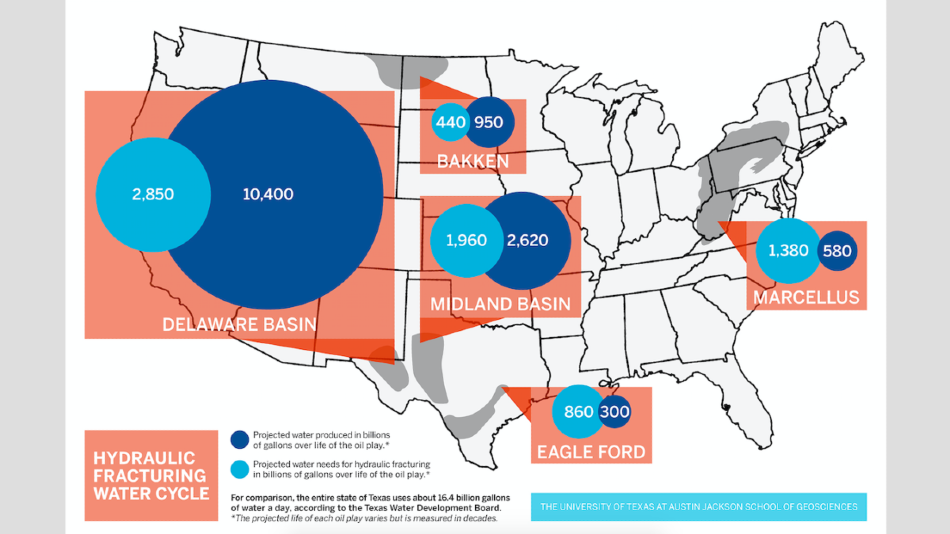Feb 21 2020
In the coming years, sufficient amounts of water will emerge from the ground as a byproduct of the production of oil extracted from unusual reservoirs. This would help to conceptually counter the need to utilize freshwater for hydraulic fracturing activities in many of the large oil-producing regions of the United States.
 Water needed for hydraulic fracturing compared to water used for hydraulic fracturing over the life of the country’s major oil plays. Image Credit: The University of Texas at Austin.
Water needed for hydraulic fracturing compared to water used for hydraulic fracturing over the life of the country’s major oil plays. Image Credit: The University of Texas at Austin.
However, while other industries, such as agriculture, may prefer to recycle some amount of that water for their own requirements, water quality problems and the possible expenses involved show that it would be best to maintain the water in the oil patch. This was the understanding gained from two recent studies headed by scientists at The University of Texas at Austin.
We need to first maximize reuse of produced water for hydraulic fracturing. That’s really the message here.
Bridget Scanlon, Senior Research Scientist, Bureau of Economic Geology, The University of Texas at Austin
Scanlon is the lead author of both studies.
For the first time, one of the studies quantified the amount of water that is generated with oil and natural gas operations when compared to the amount that is actually required for hydraulic fracturing. The study was published in the Environmental Science and Technology journal on February 16th, 2020.
In addition, the study’s authors projected water demand for hydraulic fracturing requirements and the resultant water over the life of the gas and oil plays, which cover many years. A play refers to a group of natural gas or oil fields managed by the same geology.
The other study evaluated the possibility of utilizing the water generated with natural gas and oil in other industries, like agriculture. It involved scientists from New Mexico State University, Penn State University, and The University of Texas at El Paso.
The study demonstrates that present amounts of generated water are quite small as opposed to the irrigation water demands and will not resolve the problems relating to water scarcity. The research was published in the Science of the Total Environment journal on February 3rd, 2020.
Tackling water problems has turned out to be more and more difficult with the development of oil and natural gas in traditional shale reservoirs. Operators require large quantities of water to hydraulically fracture shales to create natural gas and oil, which can be a problem in water-scarce regions.
Furthermore, huge volumes of water emerge from the reservoirs as a byproduct of oil production, which present an entirely different set of problems on how to control the generated water, specifically as science has demonstrated that pumping the water back into the deep subsurface is associated with seismic activity in certain areas.
Both studies can help inform considerable public policy discussions about water management related to the production of oil and natural gas in New Mexico, Oklahoma, Texas, and other areas of the country, added Scanlon.
The water volumes that are quoted vary widely. That’s why we did this study. This really provides a quantitative analysis of hydraulic fracturing water demand and produced water volumes.
Bridget Scanlon, Senior Research Scientist, Bureau of Economic Geology, The University of Texas at Austin
The study examined eight leading plays across the United States, including the Barnett, Bakken, the Permian (Delaware and Midland), Niobrara, Marcellus, Haynesville, Fayetteville, and Eagle plays.
The researchers utilized past data between the period of 2009 and 2017 for all the plays. Then, using present-day technology, projections were made for the life of the oil plays depending on the technically recoverable oil. Oil plays generated relatively more amounts of water when compared to natural gas plays, and the Permian Basin generated around 50 times as much water as the Marcellus in the year 2017.
Where recycling potential for hydraulic fracturing is concerned, the study demonstrates that in a majority of the cases, there is a sufficient amount of water that can perhaps be used efficiently.
For example, in the Delaware Basin, which is a portion of the greater Permian Basin located in Texas, researchers discovered that the estimated amounts of water generated will be nearly four times as high as the amount of water needed for hydraulic fracturing.
Controlling this generated water will present a major difficulty in the Delaware Basin, which is responsible for around 50% of the projected oil production of the nation. In theory, the water could be utilized by other industries like agriculture in parched West Texas, but according to researchers, water quality problems and the expenses involved in treating the briny water could pose problems.
Moreover, if the water is treated too much to eliminate all the solids, huge amounts of salt would be produced. In the Delaware Basin, the salt resulting from the generated water in 2017 alone would be enough to fill up to 3,000 Olympic swimming pools.
The ability to beneficially reuse produced waters in arid and semi-arid regions, which can be water stressed, is not the panacea that we were hoping. There is definitely potential to do some good, but it will require cautious and smart approaches and policies.
Mark Engle, Study Co-Author and Professor, The University of Texas at El Paso